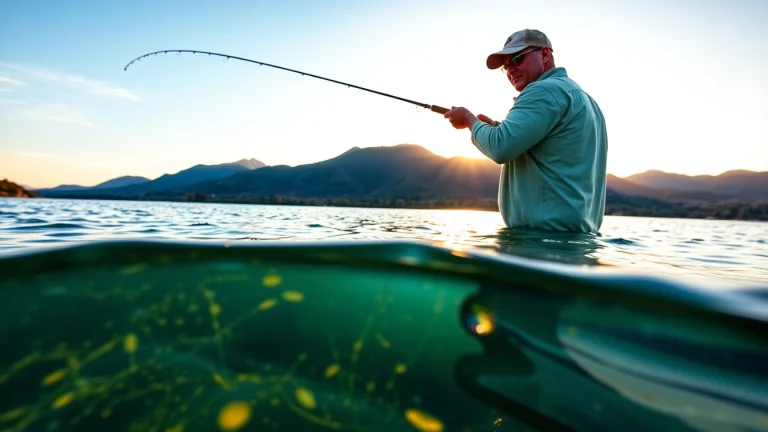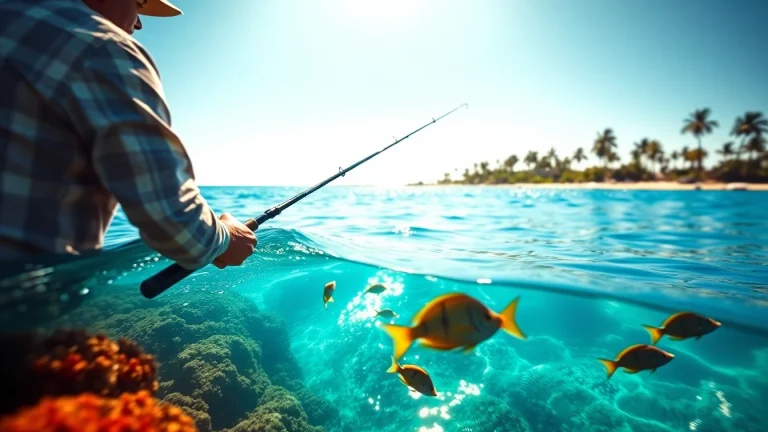
Mastering Fly Fishing for Bass: Techniques, Tips, and Essential Gear
Understanding Fly Fishing for Bass
Embarking on the journey of fly fishing for bass opens the door to an engaging and rewarding experience. This specialized angling technique allows not only for an exhilarating catch but also fosters a deeper appreciation for aquatic ecosystems. In this guide, we will explore the essential elements of fly fishing for bass, providing insights that will help both novice and seasoned anglers alike in honing their skills and maximizing their success on the water.
Essentials of Fly Fishing Equipment
To excel in fly fishing for bass, equipping yourself with the right gear is crucial. Unlike traditional fishing methods, fly fishing involves unique tackle designed to present artificial flies and entice fish. Each component of your equipment contributes to your overall effectiveness on the water.
Rods
A quality fly rod designed for bass fishing generally falls within 8 to 10 feet in length, providing the necessary leverage and flexibility. Look for a rod with a weight rating between 6 and 8, which is ideal for targeting larger bass species.
Reels
Select a fly reel that balances well with your rod choice. A suitable reel should have an excellent drag system to handle the strong pulls of bass, particularly in warmer waters where bass are known to be more aggressive.
Lines
Your fly line plays a pivotal role in your ability to cast effectively. Floating lines are favored during surface fishing, while sinking lines can be used when fishing deeper. Choose a line that well-matches the weight of your rod to enhance casting accuracy.
Types of Bass Species and Their Habitats
Understanding the different species of bass and the habitats they prefer is fundamental to improving your chances of success. The primary types of bass encountered while fly fishing include:
Largemouth Bass
Largemouth bass are the most sought-after species among anglers. These fish thrive in warm, shallow waters and are often found near structures such as docks, submerged trees, and weed beds.
Smallmouth Bass
Smallmouth bass prefer cooler waters and are typically located in rivers and lakes with rocky bottoms. They are known for their aggressive strikes and acrobatics when hooked.
Spotted Bass
Found primarily in the southeastern United States, spotted bass inhabit rivers and reservoirs, often under rocky structures or near vegetation.
Common Challenges in Fly Fishing for Bass
Despite the thrilling experience fly fishing for bass can offer, challenges abound. Being prepared to navigate these potential hurdles will enhance your overall fishing experience.
Weather Conditions
Weather plays a significant role in bass behavior. Overcast skies can encourage surface activity, while bright sun may drive fish into deeper cover.
Fishing Pressure
In areas frequented by many anglers, bass may become skittish and less likely to bite. Understanding patterns and times when fishing pressure is lower can improve your chances.
Proper Etiquette
Respecting your fellow anglers and the environment is essential. Maintaining noise levels and being mindful of shared spaces fosters a positive fishing community.
Best Techniques for Catching Bass
Effective Casting Methods
Mastery of your casting technique is vital in fly fishing for bass. Efficient casting allows for precision in delivering your fly where the fish are lurking.
Roll Cast
The roll cast is particularly useful in tight spaces where back casting may be obstructed. It allows anglers to present the fly delicately without alarming fish.
Double Haul
The double haul technique enhances casting distance effectively. It involves pulling on the line during both the back and forward cast, thus generating more speed and distance.
Understanding Weather and Water Conditions
Conditions greatly affect bass activity. Knowledge of how to read the environment will significantly aid in your fly fishing success.
Temperature
Bass are cold-blooded and their activity often correlates with the water temperature, leading them to become more active in warmer months and lethargic in colder conditions.
Water Clarity
Clear water allows bass to see the fly better, while stained water may require brighter or more pronounced patterns to attract their attention.
Choosing the Right Fly Patterns
The selection of fly patterns specifically designed for bass can make a notable difference in your catch rate. Here are some effective options:
Streamers
Streamers mimic the movement of baitfish and are particularly effective during the warmer months when bass are actively hunting for food.
Poppers
Poppers create an exciting surface disturbance, attracting bass during dawn or dusk, which are prime feeding times.
Essential Gear for Fly Fishing
Rods, Reels, and Lines: What You Need
As discussed, the backbone of your fly fishing arsenal comprises rods, reels, and lines. Ensure your gear is well-maintained and suited to your specific fishing conditions for optimal performance.
Fly Boxes and Accessories
A well-organized fly box keeps essential flies within reach. Consider having various fly types available, including streamers, poppers, and nymphs, to adapt to changing conditions.
Clothing and Safety Gear Recommendations
Proper attire not only enhances comfort but also ensures safety while fishing. Here are some key recommendations:
Sun Protection
Wear light, long-sleeved clothing and a wide-brimmed hat to shield yourself from harmful UV rays. Sunscreen is also a must.
Footwear
Invest in quality waders and boots designed for river fishing. Non-slip soles are crucial for maintaining stability on slippery surfaces.
Personal Flotation Devices
Always prioritize safety by wearing a personal flotation device, especially when fishing from a boat or around swift currents.
Where to Find the Best Bass Fishing Spots
Top Locations for Fly Fishing for Bass
Certain waters are renowned for bass fishing opportunities. Familiarize yourself with these prime locations:
Local Lakes and Ponds
Many freshwater lakes and ponds can provide thrilling bass fishing experiences. Seek out natural structures and weed beds where bass often feed.
Rivers and Streams
River systems with current provide ample feeding zones for bass. Areas where the water breaks and creates eddies are especially promising fishing grounds.
Seasonal Considerations
The bass fishing season varies depending on geographic location, but understanding the seasonal behavior of bass can guide your fishing plans:
Spring
As waters warm, bass become more active and move toward shallower areas for spawning. Utilizing the right fly patterns during this period can yield phenomenal results.
Summer
In mid-summer, bass may retreat to cooler depths or seek shelter in structures to evade heat. Adapting your fishing techniques here is imperative.
Autumn
During autumn, bass engage in aggressive feeding as they prepare for winter. This can create exciting fishing opportunities for anglers.
Winter
In colder months, bass tend to be less active. Fishing trips can be more challenging and require a deep understanding of bass behavior in low activity periods.
Local Regulations and Conservation Efforts
Understanding and adhering to local fishing regulations is critical, not just for legality but for conservation efforts as well. Various regions have specific guidelines regarding:
Catch Limits
Different habitats may have differing regulations on bag limits to ensure sustainable bass populations. Always stay informed about local rules.
Protected Species
Some bass species are protected during specific times of the year to aid in regeneration. Be mindful of these regulations to support conservation efforts.
Perfecting Your Skills in Fly Fishing for Bass
Practicing Casting Techniques
Regular practice enhances your casting precision, which can greatly influence your success rate. Set aside time for exercises focused on your casting form.
Learning from Experienced Anglers
Engaging with seasoned fly fishers can provide invaluable insights and techniques that you might not find in literature. Consider joining local fishing clubs or attending workshops.
Tracking and Measuring Your Progress
Keeping a fishing log can help you document your experiences, including conditions, locations, and the effectiveness of specific techniques. This reflection can lead to improved strategies over time.
In conclusion, mastering fly fishing for bass involves understanding gear, techniques, and the fish themselves. By investing time in learning and practicing these elements, you can ascend to become a skilled fly angler, enjoying both the challenge and the beauty of this popular pastime. The adventure awaits as you head out to the water with the knowledge and skills to make your fly fishing experience memorable and fruitful.


